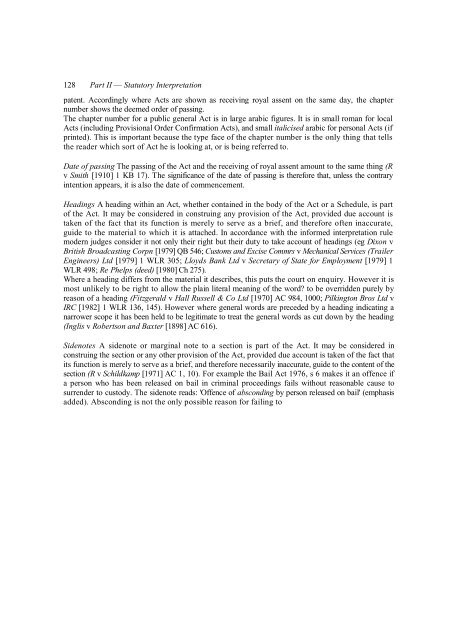Statutory Interpretation The Technique of Statutory ... - Francis Bennion
Statutory Interpretation The Technique of Statutory ... - Francis Bennion
Statutory Interpretation The Technique of Statutory ... - Francis Bennion
Create successful ePaper yourself
Turn your PDF publications into a flip-book with our unique Google optimized e-Paper software.
128 Part II — <strong>Statutory</strong> <strong>Interpretation</strong><br />
patent. Accordingly where Acts are shown as receiving royal assent on the same day, the chapter<br />
number shows the deemed order <strong>of</strong> passing.<br />
<strong>The</strong> chapter number for a public general Act is in large arabic figures. It is in small roman for local<br />
Acts (including Provisional Order Confirmation Acts), and small italicised arabic for personal Acts (if<br />
printed). This is important because the type face <strong>of</strong> the chapter number is the only thing that tells<br />
the reader which sort <strong>of</strong> Act he is looking at, or is being referred to.<br />
Date <strong>of</strong> passing <strong>The</strong> passing <strong>of</strong> the Act and the receiving <strong>of</strong> royal assent amount to the same thing (R<br />
v Smith [1910] 1 KB 17). <strong>The</strong> significance <strong>of</strong> the date <strong>of</strong> passing is therefore that, unless the contrary<br />
intention appears, it is also the date <strong>of</strong> commencement.<br />
Headings A heading within an Act, whether contained in the body <strong>of</strong> the Act or a Schedule, is part<br />
<strong>of</strong> the Act. It may be considered in construing any provision <strong>of</strong> the Act, provided due account is<br />
taken <strong>of</strong> the fact that its function is merely to serve as a brief, and therefore <strong>of</strong>ten inaccurate,<br />
guide to the material to which it is attached. In accordance with the informed interpretation rule<br />
modern judges consider it not only their right but their duty to take account <strong>of</strong> headings (eg Dixon v<br />
British Broadcasting Corpn [1979] QB 546; Customs and Excise Commrs v Mechanical Services (Trailer<br />
Engineers) Ltd [1979] 1 WLR 305; Lloyds Bank Ltd v Secretary <strong>of</strong> State for Employment [1979] 1<br />
WLR 498; Re Phelps (deed) [1980] Ch 275).<br />
Where a heading differs from the material it describes, this puts the court on enquiry. However it is<br />
most unlikely to be right to allow the plain literal meaning <strong>of</strong> the word? to be overridden purely by<br />
reason <strong>of</strong> a heading (Fitzgerald v Hall Russell & Co Ltd [1970] AC 984, 1000; Pilkington Bros Ltd v<br />
IRC [1982] 1 WLR 136, 145). However where general words are preceded by a heading indicating a<br />
narrower scope it has been held to be legitimate to treat the general words as cut down by the heading<br />
(Inglis v Robertson and Baxter [1898] AC 616).<br />
Sidenotes A sidenote or marginal note to a section is part <strong>of</strong> the Act. It may be considered in<br />
construing the section or any other provision <strong>of</strong> the Act, provided due account is taken <strong>of</strong> the fact that<br />
its function is merely to serve as a brief, and therefore necessarily inaccurate, guide to the content <strong>of</strong> the<br />
section (R v Schildkamp [1971] AC 1, 10). For example the Bail Act 1976, s 6 makes it an <strong>of</strong>fence if<br />
a person who has been released on bail in criminal proceedings fails without reasonable cause to<br />
surrender to custody. <strong>The</strong> sidenote reads: 'Offence <strong>of</strong> absconding by person released on bail' (emphasis<br />
added). Absconding is not the only possible reason for failing to

















